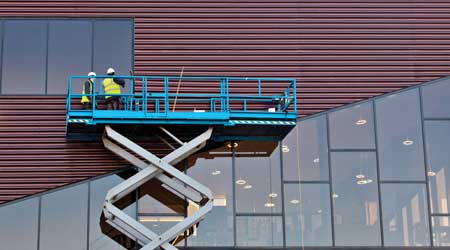 While departments generally purchase the core products in these areas, technicians also rely on managers to rent key tools and equipment, such as mobile elevated work platforms, as needed to supplement their tool and equipment arsenals.
While departments generally purchase the core products in these areas, technicians also rely on managers to rent key tools and equipment, such as mobile elevated work platforms, as needed to supplement their tool and equipment arsenals.Equipment Options To Expand the Maintenance Arsenal
Renting portable cooling units, lifts and generators can effectively supplement maintenance tools and tactics
Maintenance and engineering departments rely on a ready supply of tools, spare parts and equipment that are essential in performing inspections, repairs and maintenance. While departments generally purchase the core products in these areas, technicians also rely on managers to rent key tools and equipment as needed to supplement their tool and equipment arsenals.
While there is almost no end to the commercial rental equipment options, three types of products — portable cooling units, mobile elevating work platforms (MEWPs), and generators — are among the most versatile, popular and in demand. Successful rental experiences for these products require that managers understand the features and functions any given project demands.
Cooling considerations
The main consideration when renting a portable cooling unit is the load in tons and Btu that it will have to handle. One Btu equals the amount of heat required to raise the temperature of 1 pound of water 1 degree. One ton of cooling equals 12,000 Btu.
Ambient temperature, humidity, location, area, ceiling height, number of people, and heat-generating equipment all help determine the size of the cooling unit to rent. One general rule for sizing cooling units is to divide the total square feet in the space by 500 and multiply that result by 12,000. Add to this total 380 Btu for each person and 1,200 for each kitchen.
Consider a 600-square-foot space. Dividing that figure by 500 equals 1.2. Multiplying 1.2 by 12,000 equals 14,400 Btu. If the space contains 10 people and one kitchen, add 10 multiplied by 380 plus 1,200, or 4,200 Btu for the people and kitchen, resulting in a total of 14,400 plus 4,200, which is 18,600 Btu cooling capacity or 1.55 tons. For the greatest efficiency, a manager should select the closest size to this figure. One supplier offers units of up to 10 tons, or 120,000 Btu per hour.
Having a large number of motors or other electrical or heating equipment in a facility also will increase the heat load, so it is best to get a qualified engineer or supplier to check these variables to determine the best solution. A unit that is too small will run continuously, causing excess wear. A unit that is too large will cycle on and off frequently, which does not allow enough time to reduce humidity.
Additional considerations include the power supply, 110 volts or 220 volts, and distance to the outlet. Some units are especially built with dimensions that allow for installation in areas with low ceilings, such as a computer closet or crowded room. Large portable building air conditioners can be staged outside and cool the whole building through portable ducting to ensure occupant comfort while the building air conditioning is out of operation.
Other product features include a ventless evaporative cooler that does not require an outside exhaust and a spot cooler with ducts that aim cooled air at occupants.
Evaporative coolers require power and fresh air. They cool the air by using a supply fan that forces the air through pads that are kept wet with dripping water, which absorbs the heat from the air. The cooled air and moisture pass into the area to be cooled, so this type of cooling works best in hot, dry climates or outside areas, such as sporting events. The water drips from the pads into a collector where it recirculates, providing continuous cooling. Spot air conditioners require a power source, one or more ducts to direct the cooled air to personnel to be cooled, and a vent duct.
The supply of warm air from the room enters the unit, which works the same as a refrigerator. The refrigerant absorbs heat from the warm air and changes its state from a hot gas to a hot liquid. The hot liquid refrigerant passes through a condenser, where the heat is transferred to the outside air through the unit vent. The refrigerant is cooled, returns to the gaseous state and recycles to cool more air.
Related Topics:












